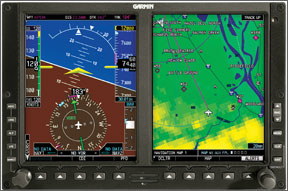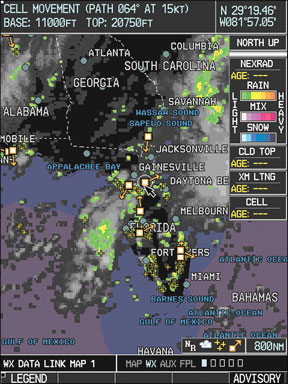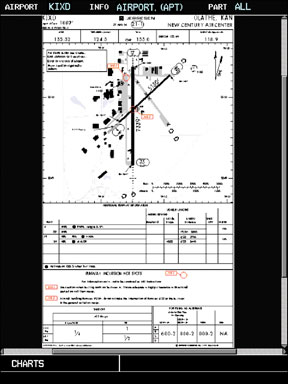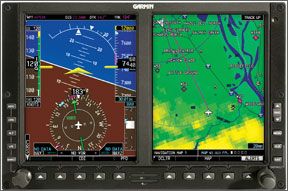Sometime dur

Second, Cheltons best-of-class displays, the FlightLogic system, also has the smallest screens. And last, we recently spent some time with Garmins new G600, which has smallish portrait-oriented screens that do what its larger sibling, the G1000, does in less than half the panel space. For once, less is more may actually be more than just a clich. The G600 we demod is at least half a year from its commercial introduction and although its we’ll along in development, the production-ready units may have design elements not evident in the prototype we examined. Nonetheless, we like what we see thus far and heres the state of play for the G600. As we reported in the September 2006 issue following the G600s debut in Oshkosh, this product is designed for the aftermarket. That means its overall size and basic architecture is intended to fit where no G1000 would dare to venture: into the panel of a 20-year-old Bonanza or Cessna with a likely tangle of orphaned wiring, static tubing and other EFIS-unfriendly junk.
Because of this, Garmin had to make the G600 smaller than the G1000 by quite a bit. The target size is a footprint thats no greater than the overall area occupied by a traditional steam gauge six pack. In the G600, this works out to a bezel frame size 10 inches in width by 6.7 inches high, with a behind-the-panel depth of about 3.5 inches and a weight of 4 pounds.
If the airplane in question doesnt have a six pack, but an older panel with scattered instruments, the G600 will still fit, but it might not be easy. (Not that it will be an easy install under any circumstances, if you ask us.) Garmins Chris Schulte a lead developer of the GNS480 when it was the CNX480 before Garmin bought the Salem, Oregon-based UPSAT told us that the largest challenge every would-be G600 buyer will have to overcome is panel structure and design. Its not that the G600 wont fit you could probably get it into a Luscombe but that there may be no room left for the remaining required instruments or that the panel will have to be perforated to fit everything.
Like all primary flight displays, the G600 will require three backup instruments an attitude indicator, an airspeed indicator and an altimeter. The attitude indicator must be driven by a secondary power source which Schulte believes will likely be a vacuum source in most airplanes.
Even in dual-alternator aircraft, an electric AI isn’t a legal option, although it might be if the aircraft also has dual batteries on an isolated bus or an electric AI with a back-up battery, such as the Mid-Continent 4200 or its new 4300 Lifesaver electric AI, with battery back-up.
An interesting test case is Aviation Consumers Mooney 231. The six pack footprint leaves more than enough room for the G600 display itself. Yank out the steam gauges, and slip in the glass. What could be simpler?
But there’s a problem. Actually, several. The rate-based S-TEC autopilot relies on the turn coordinator for bank information, so it has to go somewhere. That doesnt mean it has to be in view in the panel, but moving it behind the panel or elsewhere in the airplane ramps up installation complexity and cost. Further, we have the number 2 CDI, a Stormscope, a Shadin fuel computer and the autopilots altitude pre-select panel to the right of the six pack, where the backup instruments could otherwise be logically installed. There’s also an intercom control panel. The possibilities are intriguing, but also expensive. We could simply toss the Stormscope and use the hole for one of the three required instruments, leave the number 2 CDI where it is and find other space for the pre-select panel. As part of a general upgrade, we could also dump the old Sigtronics intercom and Shadin MiniFlo and rely on the existing Garmin GNS530 for fuel monitoring. Thats not ideal, but its a solution. We could also trade our Apollo MX-20 and free up the far right panel, solving several problems at once, albeit not elegantly.

The point being that where there’s a will, there’s a way. We doubt that many airframes will present a brick-wall no-go for the G600. Its just a question of time, money and determination. Schulte says in extreme cases, an owner could run into structural issues in cutting up the panel that might require the services of an FAA designated engineering representative to solve. We suspect this will be both rare and FSDO-dependent.
As far as the legalities and approvals, Garmin plans to introduce the G600 sometime this year with a longish approved model list, so that shops can avoid the difficult and chancy STC or field approval process. The AML route has proven the method of choice for recent major avionics products and has proven successful, although hardly seamless.
Not Just Another Box
When EFIS technology first appeared in light aircraft, first in the Cirrus and later in Cessna and other mainstream airplanes, OEMs encountered installation teething pains. Garmin has been around new product introductions long enough to expect the same with the G600.
Schulte told us Garmin will be prepared for this with detailed installation kits, instructions, training for avionics techs doing the work and a software program to elicit lessons-learned experience from the field. As with the G1000, the G600 is

comprised of separate boxes called LRUs or line replaceable units. While the G1000 architecture includes LRUs for navcomms and GPS, the G600 will rely entirely on discrete Garmin GNS430, 530 or 480 navigators for GPS and comm. In fact, the target market for the G600 is really the 75,000 or so owners of these popular navigators. Besides the display, the G600 will have three LRUs an air data computer, a magnetometer and the all-important AHRS attitude reference system, all common with the G1000. Of the three boxes, the AHRS is hands down the most sensitive to installation issues.
Location of the AHRS is critical so it senses aircraft attitude “truth” reliably and is isolated from vibration and harmonics by a robust mounting system suitable for the space available. A mounting point as near as possible to the center of the airplane is deemed best. If its too far aft, its sensing can be corrupted by tail wagging or second-order harmonics of airframe vibration.
Schulte says AHRS don’t tolerate “unassured” attitude data caused by transient attitude excursions not related to the flightpath or by vibration. These tend to be known knowns in new airplanes, but less known in older airframes. Older airplanes are also notorious for electrical noise from poorly grounded or dated wiring, ancient strobe power supplies and 30-year-old avionics. We asked if this might prove an installers nightmare? Schulte believes it wont. The G1000 is significantly hardened against electric noise and the G600 will be, too.
In flying the G600 in desktop mode, we noticed one thing: The scan is far easier on these small screens than on larger PFD/MFD combinations, where its necessary to look toward a center stack for additional flight or weather information on a larger screen. We noticed the same thing when we flew the Chelton FlightLogic last year. we’ll reserve final judgment until we fly this system in the clag, but we think Garmin is onto something.
On the PFD, the flight data representation is essentially the same as the G1000, with the exception of being narrower and having the vertical speed tape placed to the right of the HSI display. Despite its smaller area, the PFD doesnt appear cluttered, nor is the data harder to read. The overall size of the typography is similar to the G1000.
The MFD is right next door 5 inches center to center so any navigation, map, weather or traffic information you could possibly want is in the normal scan, which it is not if the MFD is a larger screen mounted in the center panel. Further, controls for PFD/MFD are also near at hand directly in front of the pilot, although comm and nav functions are limited to the GNS430s or 530s that run the G600.
There are pros and cons in this design strategy but, in our view, far more of the former than the latter. One of our consistent complaints about the G1000 is its integration of navcomm functions entirely in the displays themselves, not to mention audio panel functions in a separate panel.
While Garmin followed the basic operating logic of the 430/530 in the G1000, the casual user struggles because significant training is required to master it and regular use is the only way to remain current. In our view, thats not a marker of a good human factors design for light aircraft. Our initial impression of the G600 is that by decoupling the navcomms from display control, the system is vastly easier to operate, so much so that we sat down without a manual or any briefing and had most it figured out in 10 minutes. Further, we surmise that, as with Avidynes Entegra, once it is figured out, you wont need frequent refresher training. This presumes basic proficiency with the GNS430 or 530, boxes which we view as easy to master.
Operating Examples
Each screen of the G600 has two knobs, a single knob on the PFD side and familiar concentric knobs on the MFD. On the PFD side, a series of dedicated buttons set the knobs function for heading bug, course selection (CDI), baro setting, altitude bug and so forth. Simple stuff and, frankly, similar to Avidynes Entegra.
Along the bottom row are context-sensitive soft keys whose function changes with the task being performed. For instance, one soft key switches the CDI among various nav sources while others will be assigned to other basic display functions that our demo unit didnt have. The G600 has lots of room to expand and we suspect going forward, these keys will be given over to other functions.
The MFD is distinctly 530-like, with some 480 thrown into the mix. In fact, it sports most of the same keys and labels and uses the same chapter-and-page navigation architecture found in the 530, but the content of pages themselves varies. For instance, there’s a set-up page that allows the pilot to set custom bug values for Vx, Vy, Vso, Vlo and the like. These appear as clearly labeled bugs on the PFDs airspeed tape. Once you see the logical layout of this page, no explanation is needed: Its obvious how to use it.
There are only four chapters: maps, weather, aux and flight planning and a navigation bar along the screens bottom edge tells you where you are in the sequence. As with the GNS530, pushing and holding the clear button returns to the home map page. Soft keys along the bottom edge clearly labeled with file-folder type tabs configure things such as terrain, topo detail and so on. A menu key along the right edge of the bezel pulls up configuration options for map details such as north up tracking and what features appear and what scales. Scaling itself is with the familiar Garmin rocker key.
We found two bits of added functionality that are especially impressive. The MFD will display ships radar output from Garmins GWX 68 (see December 2006
Aviation Consumer) and the Bendix/King RDR2000 digital radar. Second, the G600 can display Jeppesens ChartView products at a scale that makes them readable but, more important, right in the primary scan next to the PFD. The G600 also has Garmin SafeTaxi diagrams, including incursion hot spots, that first debuted in the GPSmap 496 last summer.Price Value
The aftermarket for glass displays is terra incognita at the moment. Chelton probably has the most experience, but it hasnt sold anything approaching mass volumes of the FlightLogic system. No one really knows, then, if the market will be price sensitive, feature driven or both or something else. In that context, our guess is that Garmins price on the G600 $27,772 will be we’ll received; its a lot of capability for not that much money.
But wait, there’s more: add ons and installation cost. Both of these are unknowns. Our prediction is that many owners will follow the in-for-a-penny-in-for-a-pound strategy and add things like WX-500 Stormscopes, the GDL69 weather data receivers, plus traffic sensors. These could easily add another $15,000 to hardware costs and given the complexity of the installation and lack of experience doing same, we predict that total upgrade invoices in the low to mid $50s wont be unusual. Minimal installs will likely be in the high $30,000 range, in our view.
Is there much market for such high-dollar panel remodels? We think there is and it will prove profitably large, once the Garmin marketing machine is rolling. Two years from now, G600 installs will be commonplace upgrades by the GNS430/530/480 club.
Although others might demur from comparing the G600 to the G1000 apples and oranges, right? no such constraints apply to us. Were not going to roll over and say theyre both good, just different. In our estimation, the G600 is better at what it does than the G1000 is; it has a clearer design foundation and superior human factors thinking. Its the poster child for deintegration. The G1000 remains a tour de force but, in our view, its also slightly around the bend in terms of operability. If we had our choice of a new airplane with either a G600 or G1000 or a used airplane with either, we would pick the G600 in both cases. In our view, it represents for Garmin a return to its roots of sound basic functionality with curbed enthusiasm for engineering triple gainers.
Yeah, we know, the world is ruled by giant displays with lots of gimcracks because thats what we started with. But it doesnt mean we have to finish there.





